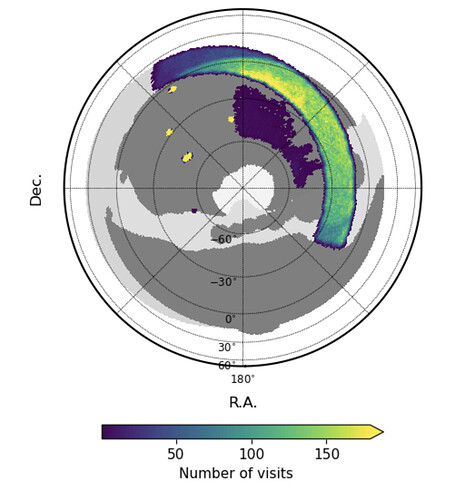As noted in recent Commissioning Updates, on-sky engineering with the integrated Rubin Observatory has been progressing towards tests of wide-area survey observing modes. The on-sky commissioning activities will conclude with autonomously driven Science Validation (SV) surveys for a period of at least 30 days.
Pilot observations for the Science Validation surveys are expected to begin in late June 2025. As more information regarding the progress of on-sky commissioning and plans for LSST Operations becomes available, Rubin Observatory has identified opportunities to refine the detailed implementation of the SV surveys to facilitate a smooth transition from Construction to Operations, and to enhance the potential impact of the Early Science Program.
The “enhanced” baseline SV survey design incorporates information regarding:
- the expected months of SV survey observations and visibility of specific target fields,
- overall operational efficiency and system performance demonstrated during the first
two months of the on-sky commissioning campaign with LSSTCam, - guidance derived from the community process to develop the LSST Cadence, facilitated
by the Survey Cadence Optimization Committee (SCOC), - input from the Rubin science community regarding the evolving scientific landscape and
emergent opportunities, - and planned engineering activities around the transition from Construction to Operations.
Rubin Observatory has now developed and simulated a Feature Based Scheduler (FBS) configuration for the enhanced baseline SV survey design that could be used for the start of pilot observations during the next weeks. Plans might be updated based on emerging understanding of the system capabilities acquired in the course of ongoing commissioning activities.
Details on the enhanced baseline SV survey design appear in Section 6 “Science Validation Survey” of SITCOMTN-005.
Rubin Observatory is still in the commissioning phase; the key objective of the SV surveys is to directly verify the as-built system and to evaluate the operational efficiency under realistic conditions. The actual volume of science-grade data collected will be directly related to the realized operational efficiency over the next several months, which includes uncertainty on the system-level performance, weather in Chilean winter, etc. The actual volume of delivered science-grade data from the SV surveys might be a fraction of the design.
